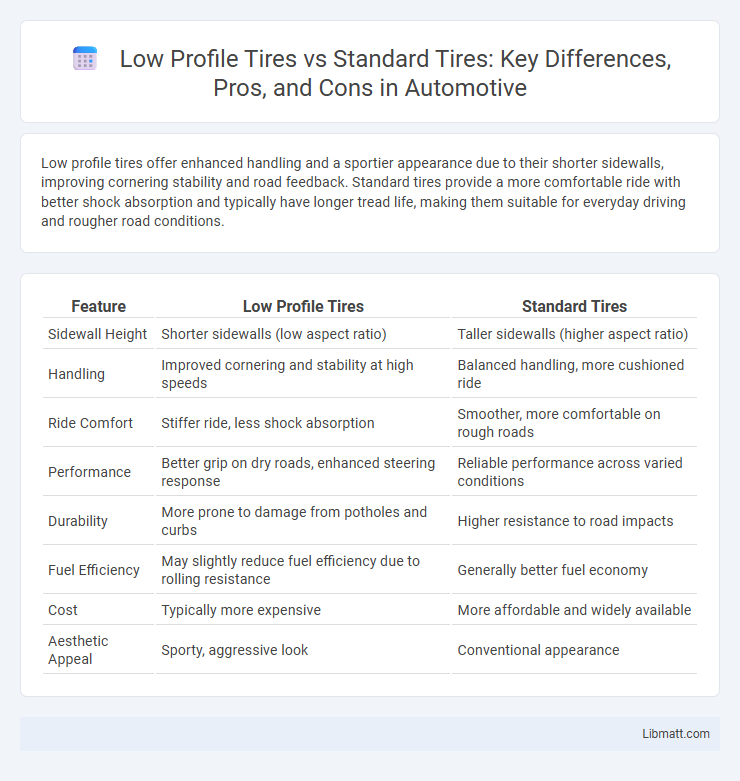Low profile tires offer enhanced handling and a sportier appearance due to their shorter sidewalls, improving cornering stability and road feedback. Standard tires provide a more comfortable ride with better shock absorption and typically have longer tread life, making them suitable for everyday driving and rougher road conditions.
Table of Comparison
| Feature | Low Profile Tires | Standard Tires |
|---|---|---|
| Sidewall Height | Shorter sidewalls (low aspect ratio) | Taller sidewalls (higher aspect ratio) |
| Handling | Improved cornering and stability at high speeds | Balanced handling, more cushioned ride |
| Ride Comfort | Stiffer ride, less shock absorption | Smoother, more comfortable on rough roads |
| Performance | Better grip on dry roads, enhanced steering response | Reliable performance across varied conditions |
| Durability | More prone to damage from potholes and curbs | Higher resistance to road impacts |
| Fuel Efficiency | May slightly reduce fuel efficiency due to rolling resistance | Generally better fuel economy |
| Cost | Typically more expensive | More affordable and widely available |
| Aesthetic Appeal | Sporty, aggressive look | Conventional appearance |
Introduction: Understanding Low Profile vs Standard Tires
Low profile tires feature shorter sidewalls compared to standard tires, enhancing cornering stability and improving steering response for sportier driving performance. Standard tires with taller sidewalls offer a more comfortable ride by absorbing road imperfections and provide better protection against rim damage. Choosing between low profile and standard tires depends on balancing performance demands with ride comfort and durability preferences.
What Are Low Profile Tires?
Low profile tires feature shorter sidewalls compared to standard tires, typically with an aspect ratio below 50%. This design enhances handling performance by reducing sidewall flex and improving steering responsiveness. Vehicles equipped with low profile tires often experience better road grip and a sportier appearance but may have a firmer ride and increased susceptibility to road damage.
What Defines Standard Tires?
Standard tires are defined by their higher sidewall height, typically featuring an aspect ratio above 55, which provides a cushioned ride by absorbing road shocks more effectively. These tires commonly range in width and diameter to fit a wide variety of vehicles, ensuring durability and comfort over diverse driving conditions. Their design prioritizes longevity and fuel efficiency, making them a preferred choice for everyday driving and long-distance travel.
Performance Differences: Handling and Stability
Low profile tires offer enhanced handling and stability due to their shorter sidewalls, which reduce flex during cornering and provide a more responsive steering feel. Standard tires, with taller sidewalls, generally absorb road imperfections better, offering a smoother ride but less precise handling. The increased contact patch and stiffness of low profile tires improve grip on dry surfaces, making them preferable for performance-oriented driving.
Ride Comfort: Low Profile vs Standard Tires
Low profile tires typically offer less ride comfort compared to standard tires due to their shorter sidewalls, which provide less cushioning over bumps and road imperfections. Standard tires have taller sidewalls that absorb shocks more effectively, resulting in a smoother and more comfortable driving experience. The trade-off is that low profile tires enhance handling and cornering performance but at the expense of increased road vibration and a firmer ride.
Tire Longevity and Wear Comparison
Low profile tires typically exhibit faster wear rates compared to standard tires due to their reduced sidewall height and stiffer construction, which transfers more road impact to the tread. Standard tires generally offer longer tread life and better resistance to uneven wear, making them more cost-effective for everyday driving. The enhanced traction of low profile tires may compromise longevity, requiring more frequent replacements.
Cost Analysis: Initial Price and Long-Term Expenses
Low profile tires generally have a higher initial purchase price compared to standard tires due to their specialized design and performance attributes. Over time, maintenance costs for low profile tires can increase because they are more susceptible to damage from potholes and uneven road surfaces, leading to frequent replacements or repairs. Standard tires typically offer lower long-term expenses due to their durability and cost-effective maintenance, making them a more budget-friendly option for everyday driving.
Impact on Fuel Efficiency
Low profile tires often have a wider contact patch and stiffer sidewalls, which can increase rolling resistance and slightly reduce fuel efficiency compared to standard tires. Standard tires, with their taller sidewalls and narrower width, generally offer lower rolling resistance, contributing to better fuel economy. Choosing tires with lower rolling resistance ratings can optimize fuel savings regardless of tire profile.
Aesthetic Appeal and Customization Options
Low profile tires enhance aesthetic appeal by offering a sportier, more aggressive look with larger wheel visibility, complementing custom rims and modern vehicle designs. They provide extensive customization options, including varied sidewall heights, tread patterns, and wheel sizes, allowing car enthusiasts to tailor their vehicle's appearance to personal style preferences. Standard tires prioritize comfort and durability but offer fewer opportunities for visual customization, making low profile tires the preferred choice for those seeking a unique and stylish finish.
Choosing the Right Tire for Your Vehicle
Low profile tires offer enhanced handling and a sportier appearance due to their shorter sidewalls and wider treads, making them ideal for performance vehicles and urban driving conditions. Standard tires provide a more comfortable ride, better shock absorption, and improved durability, which suits daily commuting and rougher road surfaces. When choosing the right tire for your vehicle, consider your driving style, road conditions, and priorities such as handling versus comfort to ensure optimal performance and safety.
low profile tires vs standard tires Infographic

 libmatt.com
libmatt.com